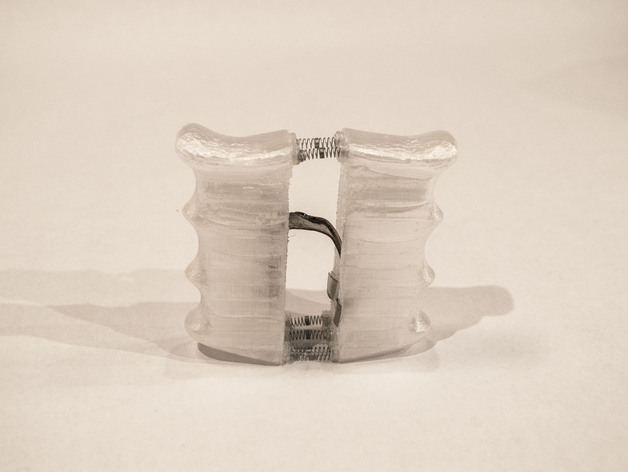
Cringe Devices
thingiverse
The cringe devices delve into the relationship between function and purpose. They serve their purpose by producing gut-wrenching noises, yet become useless because no one would willingly subject themselves to auditory torment. If the cringe devices are functional through fulfilling their purpose, but that purpose is undesirable, can they still be considered functional? The devices produce sound by scraping various materials against each other in different ways. The handheld slide cringe device (pictured first) uses metal on marble and a back-and-forth sliding motion. When the user slides the lid of the box cringe device (pictured second), styrofoam scrapes against marble. The twisting cringe device (pictured third) generates the sound of metal scraping sandpaper and ceramic when its user twists its cap. These motions cause the user to create a viscerally disturbing sound as they explore the function of each piece. Print Settings Printer Brand: MakerBot Printer: MakerBot Replicator 2 Rafts: Yes Supports: Yes Infill: 10% Post-Printing Instructions Handheld Cringe Device (pictured first): The shape of the handle was altered from jbbarlow’s design: http://www.thingiverse.com/thing:695569 Materials: Glue gun or superglue adhesive 5 Springs (taken from ballpoint pens) Marble tile or ceramic 2 flexible metal strips (about 2” in length) Print the file as is with supports and raft. When the 3D print is complete, glue the 5 springs into the 5 tube-slots on one half of the handle. Glue a piece of marble and/or ceramic no larger than .5” x 2.5” into the handle with the deeper hollowed out area. Glue the strip of metal into the more-shallow handle so that the length of the metal strip bends to form a “u”. This bend must extend so that the strip scapes the marble of the opposite handle when the two handles are pushed against each other. Optional: If the glue adhesive is not sturdy enough the keep the metal strip in a fixed position, bend and glue a second strip of metal perpendicular to the attached area of the first to create a more secure structure. Finally, glue the other ends of the springs to the second handle’s tube-slots, fixing the two handles together. To use, push the handles together and slide up and down, causing the metal to scrape against the ceramic! Enjoy! Sliding Box Cringe Device (pictured second): The box was altered from Finch’s design: http://www.thingiverse.com/thing:194066 Materials: Glue gun or superglue adhesive Marble tile or ceramic Styrofoam Print the file as is with supports and a raft. When the 3D print is complete, sand the edges of the box so that the lid can comfortably slide along the edge of the box on the track. The side of the lid with the handle is the outer side. Glue ceramic and/or marble tile to the bottom of the box. The pieces should all be the same height. Fill in the uncovered areas of the bottom with bits of styrofoam cut to exact size. Glue styrofoam piece(s) (recommended: .75” x .75” x.75”) to the flat side off the lid. The styrofoam should reach the pieces of marble tile within the box. The rectangular piece that printed with the box can be used to support the pieces of styrofoam. Slide lid back and forth along track to generate the sound of styrofoam on tile. Twisting Cringe Device (pictured third): Materials: Glue gun or superglue adhesive Water bottle cap Coarse sandpaper Thin metal strips Stiff wire Broken ceramic or tile Alter the dimensions of the file so that the cylinder’s inner circumference is slightly smaller than the circumference of your water bottle cap. The outer circumference of the cylinder should be slightly larger. After printing, glue the sandpaper to the bottom of the cylinder’s interior. It helps to use the excess sandpaper to cover the sides of the bottom as well. Glue the metal strips and wires to the inside of the water bottle cap. They should be the same length as the printed cylinder’s interior, so that the metal scrapes the sandpaper when the cap is twisted. Note: It’s essential that the cap is almost entirely covered in wires and strips to generate the noise. Glue the bottom component of the water bottle cap to the top of the cylinder. Place small chunks of ceramic inside of the cylinder. Twist the cap onto its bottom attachment, generating the sound of wire on sandpaper.
With this file you will be able to print Cringe Devices with your 3D printer. Click on the button and save the file on your computer to work, edit or customize your design. You can also find more 3D designs for printers on Cringe Devices.
